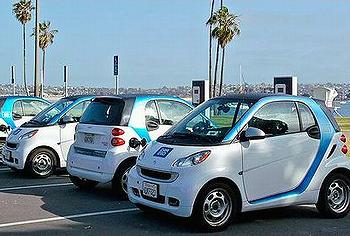
WASHINGTON, DC, April 30, 2013 (ENS) – Consumer demand for new fuel-efficient vehicles is high in the United States and electrics are gaining in popularity, finds a new analysis by the Consumer Federation of America, an association of more than 260 nonprofit consumer groups.
The analysis, “On the Road to 54.5 MPG: A Progress Report on Achievability,” provides the first progress report on the response of consumers and automakers as both begin to experience the effects of the newly adopted 54.5 mile per gallon federal fuel economy standard.
The Obama Administration’s new standard was finalized on August 28, 2012. It builds on the success of the administration’s standards for cars and light trucks for model years 2011-2016 that raised average fuel efficiency of the U.S. fleet by 2016 to the equivalent of 35.5 mpg.
“Looking at current market offerings, consumer purchasing trends and our surveys of consumer demand, there is no doubt that the federal effort to significantly raise fuel economy is benefiting consumers, car companies, autoworkers and the environment,” said report co-author Jack Gillis, CFA’s director of public affairs and author of “The Car Book.”

In the first nationwide poll by the Consumer Federation since the new standard was adopted, 85 percent of respondents said they “support” the requirements, with 54 percent saying they “strongly support” the standard.
This support extends across the political spectrum, with 77 percent of Republicans, 87 percent of Independents and 92 percent of Democrats saying they support the higher fuel efficiency standards.
Fuel economy will be an “important” factor for 88 percent of respondents in their next vehicle purchase, 59 percent say it will be a “very important” factor.
Those who say fuel economy is very important expect to get 12 more miles per gallon from their next vehicle than those who say it is not important.
Consumers intend to purchase even higher mileage vehicles going forward. Those who indicated that their current gas mileage was 24 mpg and who intend to purchase a vehicle in the future, expect a seven mpg increase, or to get 31 mpg from their next vehicle.
More than half (57%) of respondents who said they intend to purchase an SUV said they want its fuel economy to be at least 25 mpg.
“These results should lay to rest any concerns that some car dealers had about consumer demand for more fuel efficient vehicles,” said Gillis.
In spite of the support of car companies, unions, consumer and environmental groups, the National Automobile Dealers Association was the only major entity opposed to the new requirements.
“What is remarkable is that improvements in engine efficiency, driven by the standards and consumer demand, resulted in a significant increase in four-cylinder vehicles with little compromise in performance,” said CFA’s Director of Research Mark Cooper.”
“Increasing mileage performance is also reflected the growing sales of hybrid and electric vehicles, which have doubled in sales during the past four years to over half a million vehicles,” said Cooper.
“Despite what many media pundits would have you believe, consumer acceptance of electric vehicles is higher than acceptance of hybrids when they were first introduced,” said Cooper. “As battery technology improves and prices go down, there is no question that electrics will play an important role in meeting consumer demand for higher efficiency.”
Consumer demand for higher-mileage and alternative fuel vehicles is a function of the enormous impact that gas costs have on the average wallet, Cooper concludes.
“In looking at what consumers paid for gasoline in 2012, we determined that the average car-owning household spent $3000. That’s 50 percent more than the total amount they spent on the energy costs needed to run their homes,” said Cooper. “Our analysis has consistently shown that increases in vehicle prices are more than offset by savings from gasoline purchases.”
Comparing popular 2009 models with 2013 models, the Consumer Federation analysis shows that the percentage of vehicles getting at least 30 mpg rose from four to 12 percent.
Over the same time period, the percentage of popular vehicles getting at least 23 mpg rose from 30 to 56 percent; and the percentage getting under 22 mpg fell from 70 to 44 percent.

Spurred by the higher government standard and greater consumer demand, automakers are increasing the mileage of the vehicles they produce.
Between 2009 and 2013, the percentage of total available models getting at least 30 mpg rose from one to nine, while the percentage of those getting less than 15 mpg fell from 15 to three.
Over the past six years, there were even greater mileage improvements for many individual models. Standouts include the Chevy Malibu (went from 20 to 29 mpg), the Honda Accord (went from 24 to 30 mpg), the Nissan Altima (went from 26 to 31 mpg), the Ford Escape (went from 19 to 25 mpg), and the Ford Fusion (went from 21 to 26 mpg.)
Many automakers have vehicles on the market that are already meeting the new standard.
Of the 134 different car models available in 2013, the Consumer Federation found that 64 (49 percent) include a model that already meets the 2014 mpg standard.
The analysis found that 32 (24 percent) have a model that meets the 2017 standard, and 12 models (nine percent) already meet the 2025 standard.
“The decision to reform and restart the fuel economy program has played a much larger part in triggering the increase in fuel economy than gasoline prices, although they matter too,” Cooper said.
“The impact of the standard and the dynamic response of the market are strong indicators that the long-term goal of 54.5 miles per gallon by 2025 is achievable and in the consumer and national interest, which is why it enjoys such widespread support.”
Click here to read the Consumer Federation report.
Copyright Environment News Service (ENS) 2013. All rights reserved.
© 2013, Environment News Service. All rights reserved. Content may be quoted only with proper attribution and a direct link to the original article. Full reproduction is prohibited.
